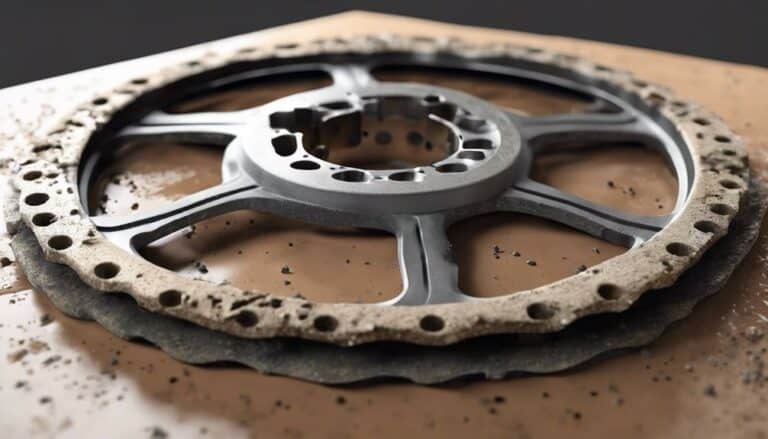If high-pitched squeaking or grinding noises occur when braking, it's time for maintenance. Look out for longer stopping distances, spongy brake lever, or uneven braking. A dirt bike pulling to one side when braking signals an issue. Vibrations in the brake pedals indicate potential problems. Check for visible wear on brake pads, discs, and calipers. Taking proactive steps can prevent major issues. Essential brake maintenance is vital for safety and performance.
Key Takeaways
- High-pitched squeaking or grinding noises while braking.
- Longer stopping distance or uneven braking performance.
- Spongy brake lever feel or dirt bike pulling to a side.
- Vibrating brake pedals affecting braking efficiency.
- Visible wear on brake components like pads, discs, calipers, and lines.
Squeaking or Grinding Noises
If you hear high-pitched squeaking or grinding noises when braking your dirt bike, it's important to address these sounds promptly to guarantee peak brake performance. These noises are often indicators of worn brake pads that may require replacement. Squeaking typically signifies that the brake pads have worn down and are nearing the end of their lifespan. On the other hand, grinding noises suggest that the brake pads have worn to the point where there's metal-to-metal contact, which can lead to damage within the braking system.
To prevent further damage and guarantee peak performance, inspect your brake pads regularly for any signs of wear. When you notice these unusual noises, it's essential to address them promptly by replacing the brake pads. By staying proactive in inspecting and maintaining your dirt bike's brakes, you can avoid compromising your safety and the efficiency of your braking system. Regular maintenance is key to preserving the integrity of your dirt bike's braking components.
Reduced Braking Efficiency
Reduced braking efficiency on a dirt bike is often indicated by a longer stopping distance than usual. This can compromise your safety and control over the bike. When experiencing reduced braking efficiency, it's important to address the issue promptly to guarantee your dirt bike's brake system functions at its best.
Signs of reduced braking efficiency may manifest in various ways:
- Spongy Brake Lever Feel: A mushy or spongy brake lever feel can suggest air or moisture in the brake lines, hindering the braking system's effectiveness.
- Uneven Braking Performance: If your dirt bike pulls to one side when braking, it indicates potential brake issues that need attention to maintain balanced braking performance.
- Vibrating Brake Pedals: Vibrating brake pedals signal compromised braking system functionality, requiring inspection to restore smooth operation and ensure rider safety.
Ignoring signs of reduced braking efficiency, such as a longer stopping distance, can lead to overheating brakes and further deterioration of your dirt bike's braking system. Regular maintenance is essential to address brake issues promptly and maintain top-notch braking performance.
Spongy Brake Lever Feel
To guarantee peak braking performance on your dirt bike, pay attention to the brake lever feel, as a spongy sensation can indicate potential issues with the brake lines. Signs of a mushy or soft brake lever suggest a lack of importance, which is essential for effective braking.
A mushy lever may signal worn or expanded brake lines, reducing the pressure within the system and ultimately leading to less responsive braking. It's essential to regularly check the condition of your brake lines to make sure they're in best working order.
Vibrations or Pulsations
When experiencing heavy vibrations while applying the brakes on your dirt bike, it may indicate potential issues with warped brake rotors. Warped rotors are common problems, especially with OEM or poorly made rotors.
To address this, consider the following:
- Inspecting Brake Rotors: Regularly inspecting your brake rotors can help identify any warpage issues early on.
- Choosing Quality Rotors: Opting for high-quality rotors, such as Galfer Wave rotors, can reduce the likelihood of experiencing heavy vibrations during braking.
- Understanding Common Issues: Educate yourself about common brake problems like warped rotors to take proactive steps in maintaining your dirt bike's braking system.
Visible Wear on Brake Components
Examining your dirt bike's brake components for visible wear is crucial to guarantee top performance and safety.
Start by checking the brake pads for visible wear indicators, such as a disappearing groove or thickness measuring 2mm or less. Look for any signs of uneven wear and note their positions to ensure proper reassembly.
Inspect the brake discs for warping, scoring, or uneven thickness, as these issues can affect braking efficiency.
Additionally, examine the brake calipers for sticking pistons, leaks, or corrosion, which can lead to braking problems.
Make sure to also inspect the brake lines for any fraying, leaks, or damage that could compromise the braking system.
Addressing visible wear on brake components promptly can prevent issues like warped discs or sticking pistons, ensuring your dirt bike's brakes operate effectively when you need them most.
Conclusion
To sum up, when it comes to dirt bike brake maintenance, it's important to pay attention to warning signs like:
- Squeaking or grinding noises
- Reduced braking efficiency
- Spongy brake lever feel
- Vibrations or pulsations
- Visible wear on brake components
Remember, 'an ounce of prevention is worth a pound of cure.' Regular maintenance and prompt action can help guarantee your dirt bike's brakes are in top-notch condition for safe and enjoyable rides.

